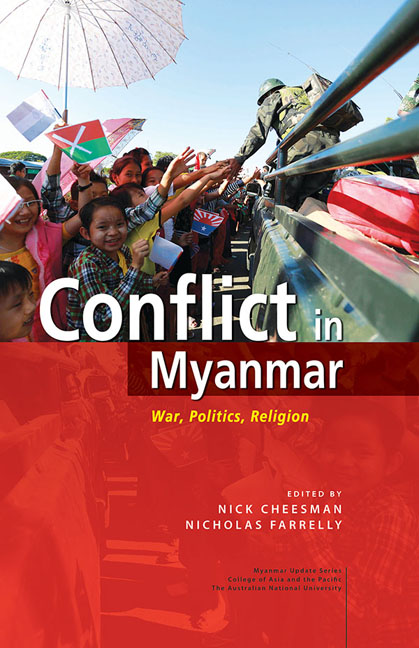Book contents
- Frontmatter
- Contents
- List of Maps
- List of Tables
- List of Figures
- Acknowledgements
- Contributors and Editors
- Part I Introduction
- Part II War and Order
- 2 The politics of policymaking in transitional government: A case study of the ethnic peace process in Myanmar
- 3 Reexamining the centrality of ethnic identity to the Kachin conflict
- 4 A feminist political economy analysis of insecurity and violence in Kachin State
- 5 Pacifying the margins: The Pa-O Self-Administered Zone and the political order in southern Shan State
- 6 Landmines as a form of community protection in eastern Myanmar
- Part III Elections and After
- Part IV Us and Them
- Part V Conclusion
- Abbreviations and Key Terms
- Index
2 - The politics of policymaking in transitional government: A case study of the ethnic peace process in Myanmar
from Part II - War and Order
Published online by Cambridge University Press: 22 July 2017
- Frontmatter
- Contents
- List of Maps
- List of Tables
- List of Figures
- Acknowledgements
- Contributors and Editors
- Part I Introduction
- Part II War and Order
- 2 The politics of policymaking in transitional government: A case study of the ethnic peace process in Myanmar
- 3 Reexamining the centrality of ethnic identity to the Kachin conflict
- 4 A feminist political economy analysis of insecurity and violence in Kachin State
- 5 Pacifying the margins: The Pa-O Self-Administered Zone and the political order in southern Shan State
- 6 Landmines as a form of community protection in eastern Myanmar
- Part III Elections and After
- Part IV Us and Them
- Part V Conclusion
- Abbreviations and Key Terms
- Index
Summary
In a country such as Myanmar, which has long been in a constant state of civil war, there is no better reform agenda for a new government than negotiations with armed opponents. Given the long history of military rule in Myanmar, where fighting regularly breaks out between the Burman-dominated armed forces (Tatmadaw) and ethnic armed groups (EAGs), ethnic reconciliation has been one of the challenging tasks for successive governments. After the Tatmadaw's withdrawal from direct political rule in March 2011, the new quasi-civilian government placed persistent attention on the ethnic negotiation issue by bringing ethnic leaders to the table for peace talks. Unlike in the past, where the Tatmadaw (on behalf of both the military government and the armed forces) made ceasefire deals with the EAGs directly, the new peace process in Myanmar put the government and the Tatmadaw in different roles. The quasi-civilian government acted as a negotiating institution between two key stakeholders of the peace process: the Tatmadaw and the EAGs.
Coming during a political transition, the peace talks have been fragile. The talks have sometimes produced promising deals between the Tatmadaw and the EAGs. At other times, disputes between the Tatmadaw and ethnic leaders pertaining to political and security issues have seriously impeded talks. Such political and security issues range from the country's internal domestic affairs — such as heated discussions of “federalism”, and “demobilize, disarm, reintegration” (DDR) — to the country's diplomatic affairs, such as different preferences between the military and EAGs on choices of international observers as foreign witnesses to sign a nationwide ceasefire agreement.
Nevertheless, to the surprise of many scholars and political observers, the Thein Sein government continued to manage its hold on the fragile peace process until the end of its administration in 2015. As a major milestone of the process, the government signed a ceasefire deal with the Tatmadaw and eight EAGs just a month prior to the November 2015 general election, while inviting seven other EAGs, which did not sign at this time, to continue joining the process.
How did the Myanmar transitional government sustain the peace process despite political and security constraints? Analysts have offered different explanations. Attention has been paid to both the characteristics of leaders and of institutions.
- Type
- Chapter
- Information
- Conflict in MyanmarWar, Politics, Religion, pp. 25 - 46Publisher: ISEAS–Yusof Ishak InstitutePrint publication year: 2016



